MONTESSORI PROJECT
|
Click on these dates/links, to see Susan's emails and pictures Bhutan 2008 — Main page for 2008 trip |
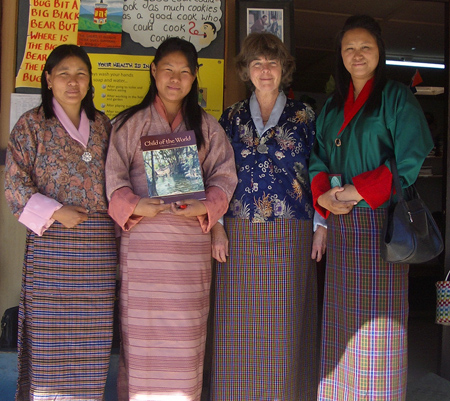 |
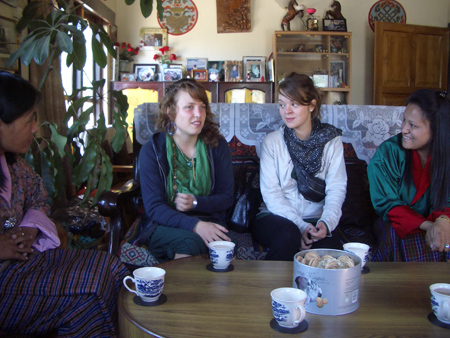 |
Teacher in a Thimphu school, Susan, principal |
Two Swiss visitors, the one in green went to this school when she was young and it was a Montessori school |
HELLO ALL, MONTESSORI ELEMENTARY STUDENTS AND FRIENDS, This morning I finished all the observations needed to make a plan to help further Montessori in Bhutan. We have observed two monasteries where young children have, for hundreds of years, received a traditional education on the way to behave, become better, help others, be good monks. Then two traditional modern schools influenced by schools in the West (children the same age in the same class, adults deciding when and what and how they study), and two schools with a bit of Montessori influence (but never for more than 1/2 hour a day). |
While visiting one of these schools in Thimphu, a young woman just out of high school in Switzerland appeared. Gunilla and Dendy and I were having tea with the principal. The young lady and a friend were traveling around Asia for 3 months. She had attended this Thimphu school when it was a Montessori school. She had studied there for 5 years while her parents were working in Bhutan. Beyond this experience in Bhutan she had never even seen a Montessori class, yet she had strong memories of pouring and folding, and had looked forward very much to visiting. See! It is the real work that is the most engaging, and the most remembered! |
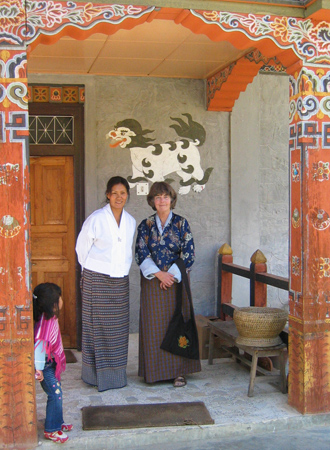 |
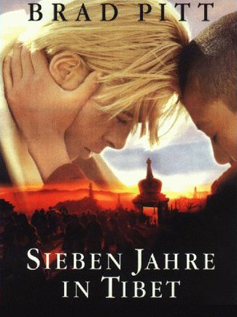 |
| Teacher Wangmo (pronounced Omo) in front of her school, with Susan and a student | 7 Years in Tibet, Brad Pitt and Wong's son on the cover of this German version of the 1997 film |
At another of the "Montessori" schools I visited with the director whose sons had been in the movie "7 Years in Tibet." (I put Montessori in quotation marks because these are schools with AMI Montessori training of the principals but no trained Montessori teachers in the classroom, so they are not examples of real Montessori. The teacher must be thoroughly trained for this system to work.) Here is her story: When the boys were 8 and 13, and the family were visiting friends in Hong Kong, one of the boys came home from a store, where he had gone to buy a cassette tape, with the exciting news that a person there was casting for a movie and asked if the boy would like to be in it. |
The parents discounted the very idea, but when the boys were asked again the second day, they decided to investigate. It was true. There was to be a movie about the Dalai Lama filmed in Argentina for 5 months. It was to be based on the book Seven Years in Tibet. Since the boys are Northern Bhutanese, many such families having come from Tibet, they looked Tibetan. So the family moved to Argentina to be in the movie. The Dalai Lama's sister, Jetsun Pema, who was in charge of the Montessori and other classes for Tibetan refugees in Indiana for many years, was there to help and play the Dalai Lama's mother in the beginning of the movie. Wangmo's sons play the Dalai Lama himself at age 8 and at age 13. If you see the movie you will see them! |
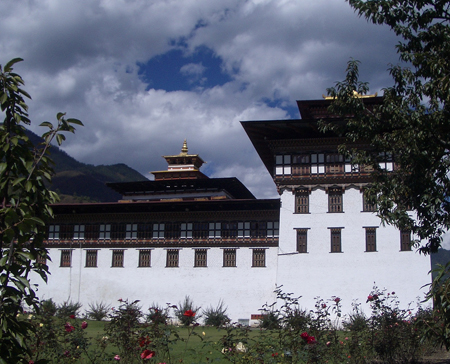 |
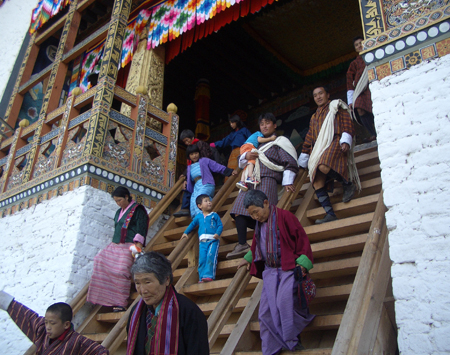 |
One of the Dzongs in Bhutan, traditional architecture use in all buildings |
Ladder Steps, as at the entrance of this dzong, are used in all traditional buildings and even homes |
Also the movie "Little Buddha" is very interesting because it is filmed in Seattle, Kathmandu, and here in Bhutan. It is filmed at the Dzong in Paro (one of my paintings of a children's class in this monastery can be seen here: http://michaelolaf.net/children.html). Woven through the story of searching for a reincarnation of a Tibetan lama is a flashback to the story of the life of Buddha. Buddha is not a God, but was a prince in a wealthy family in a place that used to in India and is now called "Nepal." He had been protected from seeing sickness, old age, and death, by his father. When he finally did see these things, when he discovered that unhappiness exists, after he had experienced a life of only beauty and comfort, he spent many years trying to figure out what made people sad, and how to help them become happy. The movie shows the mythology of his story and is a great introduction to Buddhism. |
If you want to learn more about how Buddhists practice is geared to being happy, and making other people happy, look up the "8-fold path" and see if you want to use these ideas in your own life. Like Buddha, the Dalai Lama has also been turned into a god by many people. This is not his doing as he always insists that he is "a simple monk" and he still studies the Buddhists texts each day to learn more, to be a better person, to help create happiness for other people, and animals, "all sentient beings." For older students and adults reading this email who really want to learn more about the history of theDalai Lama, and the reasons many of the Tibetans have left India, and settled in India, Nepal, and Bhutan, there is a recent documentary DVD called "Cry of the Snow Lion" which is moving and educational. |
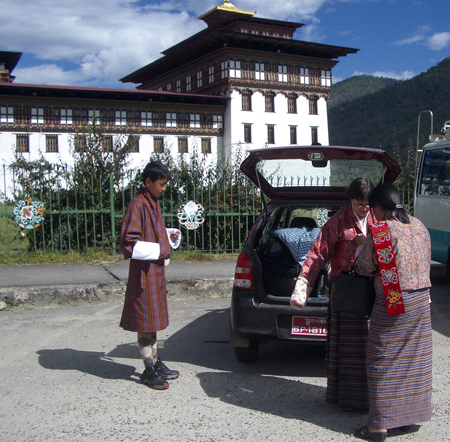 |
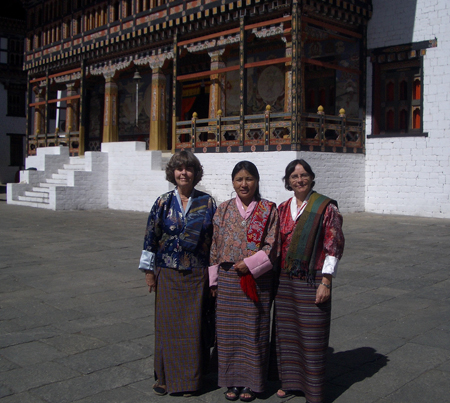 |
Dendy redoing Gunilla's outfit so we could enter the Punakha dzong |
Susan, Dendy, and Gunilla inside the dzong, properly dressed |
Everywhere we go people smile and tell Gunilla and me that we look very beautiful. Perhaps for one reason, youth and a svelte figure are not desirable in woman as we have made it in the West. People are expected to look their age, and with age comes wisdom. I am really starting to feel beautiful. But aside from that cultural difference, they think we look lovely because we are wearing the traditional clothing of Bhutan when we go anywhere where we might need to enter a government office, or a temple, or a dzong. Twice we have had a problem with our clothing not being perfect. It is the rule that if you are a foreigner and dressed in your own cultural clothing (like jeans) you can enter a dzong dressed as you are. But if you are dressed even partially in Bhutan dress you must do it correctly. So twice we had to do better. |
At the Punakha dzong, the most beautiful dzong in all of Bhutan, where the coronation ceremonies were to begin shortly after we were there, Dendy, Gunilla and I were all wearing the traditional half kira (skirt). Dendy and I were wearing the wongjo (blouse) and dego (jacket) but Gunilla was not, so we had to go back to the car to get hers. Also, in dzongs it is required that one wear the kamnay (beautifully decorated scarf about 4-12 inches wide that one places over the left shoulder.) Dendy was perfectly dressed but neither Gunilla nor I had even brought ours from Paro to Thimphu so we had to find similar scarves to fold up and use. We do not mind these inconveniences because we are representing our countries, and want to show all the respect possible for the culture of Bhutan. LOVE, |
Return to the Bhutan Montessori Project home page — Bhutan, 2006 Return to Michael Olaf Children's Projects — Projects |
|